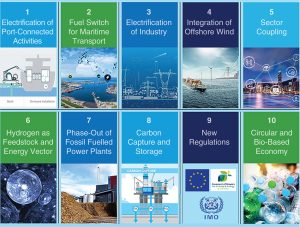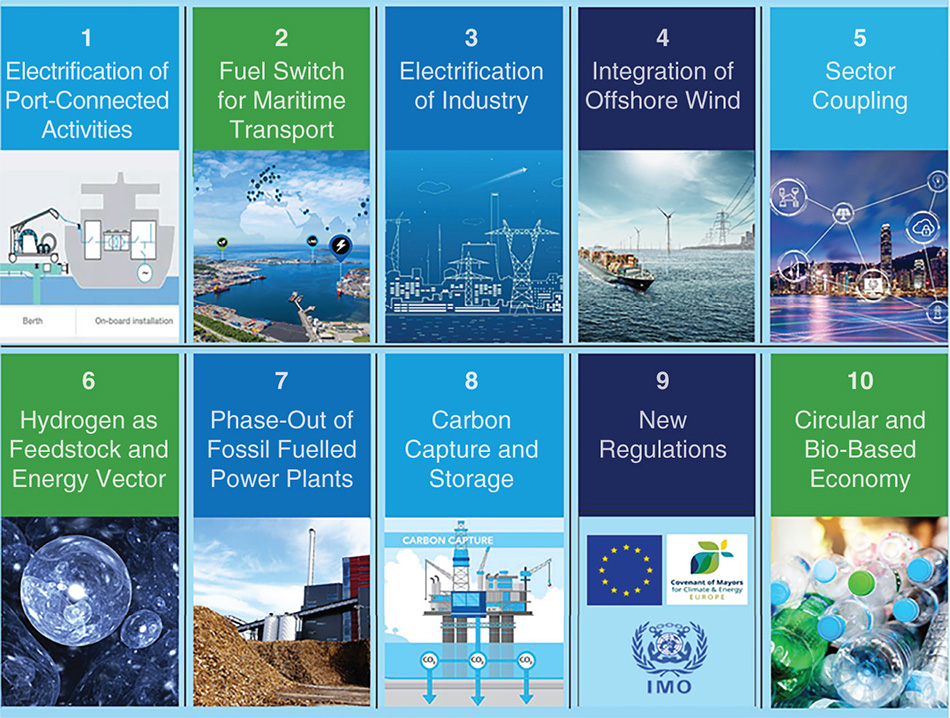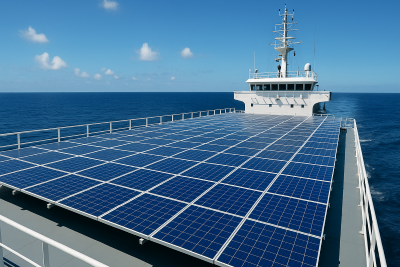Electrification of Ports: A Case for Clean Docking
Introduction

In recent times, the electrification of ports has become a revolutionary approach for decreasing greenhouse gas emissions and enhancing air quality in coastal urban areas. As global commerce increasingly depends on maritime shipping, ports function as essential hubs within the supply chain. Nonetheless, the activities at these busy locations—particularly the emissions from docked ships—present considerable ecological challenges. Consequently, the electrification of port facilities, especially through the implementation of shore power, is gaining traction as a cleaner and smarter option.
This blog delves into the significance of electrification for ports, the mechanics behind it, its environmental and economic effects, and what the future holds for environmentally friendly docking practices.
What Is Port Electrification?
In simple terms, port electrification involves incorporating electric power sources into port operations to substitute fossil fuel-dependent systems. One prevalent method is shore-to-ship power, commonly referred to as shore power, cold ironing, or alternative maritime power (AMP). This system enables vessels to connect to the local electricity grid while docked, eliminating the need to run their diesel engines.
As a result, ships can maintain their onboard systems—such as lighting, air conditioning, and cargo handling machinery—without generating harmful emissions. Additionally, other port activities, including cranes, forklifts, and cargo transport vehicles, can also be electrified to diminish overall emissions within the port environment.
Why Clean Docking Matters
The environmental effects of ships idling at ports are considerable. Even while stationary, vessels consume marine diesel or heavy fuel oil to sustain onboard operations. This practice releases:
- Nitrogen oxides (NOₓ)
- Sulphur oxides (SOₓ)
- Particulate matter (PM)
- Carbon dioxide (CO₂)
These pollutants not only contribute to climate change but also degrade air quality in surrounding urban regions. Port cities frequently face higher rates of asthma, cardiovascular diseases, and other health issues related to pollution. Thus, electrification plays a crucial role in promoting public health and environmental equity, especially in low-income neighborhoods that are often situated near major ports.
How Shore Power Works
To appreciate the advantages of shore power, it’s essential to understand how this technology operates. When a vessel docks at a port that offers shore power:
- The ship turns off its auxiliary engines.
- Specialized cables link the vessel to the port’s electrical grid.
- Power converters ensure that the electricity from the grid is compatible with the ship’s onboard systems.
- The vessel receives electricity—usually derived from renewable or low-carbon sources—through this connection.
Additionally, international standards such as ISO/IEC/IEEE 80005-1 help to standardize the procedure, ensuring that ports and ships can operate compatibly worldwide. This standardization is crucial for the expansion of shore power infrastructure across various regions.
Benefits of Electrifying Ports
Electrification presents numerous compelling benefits—environmental, operational, and economic.
-
Environmental Advantages
Undoubtedly, the most notable benefit is the substantial decrease in emissions. By transitioning from diesel to electric power:
- CO₂ emissions have the potential to decrease by 30–60% contingent upon the composition of the energy mix utilized.
- Emissions of SOₓ and NOₓ can be curtailed by as much as 90%.
- Noise pollution attributable to engine idling is also significantly mitigated.
When the electricity is derived from renewable sources, the effect becomes even more pronounced. For example, a port that employs solar or wind-generated grid electricity can function almost entirely devoid of carbon emissions during shore connections.
-
Operational Effectiveness
In addition to emissions reduction, electric systems frequently provide enhanced energy efficiency. Electrical apparatus typically necessitates less maintenance, operates with greater acoustic discretion, and affords superior precision in terms of movement and loading.
Moreover, as the processes of automation and digitalization proliferate within ports, electrification emerges as the foundational element for intelligent port systems. These integrated technologies facilitate real-time data analysis, improved cargo management, and optimized logistical operations.
-
Economic Factors
Although the initial capital investment is substantial, the potential for long-term cost savings can be significant. Decreased fuel consumption, diminished maintenance expenses, and prospective tax incentives all contribute to the overarching financial benefits.
Additionally, as regulatory pressures intensify, compliance costs associated with traditional operations are anticipated to escalate. Electrified ports, conversely, may reap the advantages of green port incentives, carbon credits, and enhanced competitiveness within sustainability-oriented markets.
Global Examples
A number of progressive ports have already adopted electrification, thereby providing concrete illustrations of its benefits.
Port of Los Angeles and Long Beach, USA
Frequently referenced as trailblazers, these Californian ports were among the inaugural adopters of extensive shore power infrastructure. Consequently, they have realized considerable reductions in emissions, particularly regarding SOₓ and NOₓ, while continuing to broaden their clean energy initiatives.
Port of Gothenburg, Sweden
In Northern Europe, the Port of Gothenburg has outfitted all its quays to accommodate shore power. Notably, the electricity supplied is generated from renewable sources, thereby positioning the port as a global frontrunner in sustainable docking practices.
Port of Shanghai, China
As one of the most heavily trafficked ports worldwide, Shanghai has made significant investments in shore power for both domestic and international vessels. Government incentives and policy mandates have expedited the adoption of this technology, resulting in measurable enhancements in local air quality.
These case studies illustrate how various regions, despite differing regulatory frameworks and economic conditions, can successfully implement electrification.
Obstacles to Implementation
Notwithstanding its numerous advantages, port electrification encounters several obstacles that necessitate resolution.
-
High Initial Investments
The installation of shore power systems demands considerable financial outlay for infrastructure, including power substations, cabling systems, and retrofitting of vessels. For smaller or developing ports, such costs can be prohibitive.
-
Compatibility Challenges
Not all vessels are equipped to utilize shore power, particularly older ships. Therefore, the harmonization of technology across fleets and ports is critical, albeit complex.
-
Grid Stability and Capacity
The local electrical grid must possess the capability to accommodate the additional load imposed by multiple vessels connecting simultaneously. In certain regions, upgrades to the grid infrastructure are imperative prior to achieving full electrification.
-
Policy and Regulatory Shortcomings
While some nations have instituted stringent emission controls and incentives, others exhibit a lack of clear regulatory support. As a result, the pace of adoption varies considerably across different jurisdictions.
The Importance of Policy and Global Cooperation
To speed up the electrification of ports, effective policy frameworks and international collaboration are essential. For instance:
- The European Union backs shore power through its Alternative Fuels Infrastructure Regulation (AFIR), which requires shore-side electricity at significant EU ports by 2030.
- In the United States, the Environmental Protection Agency (EPA) provides funding through the Diesel Emissions Reduction Act (DERA) for electrification initiatives.
- The International Maritime Organization (IMO) advocates for emission reductions via MARPOL Annex VI and is contemplating the inclusion of shore power usage in its worldwide strategies.
These initiatives not only offer financial support but also establish a fair competitive environment for ports and shipping companies globally.
Looking Forward: The Future of Eco-Friendly Docking
As the shipping industry moves towards decarbonization, the electrification of ports is expected to become a standard practice rather than an optional choice. Progress in battery storage, renewable energy integration, and smart grid technologies will further improve the effectiveness of clean docking.
Additionally, we can anticipate:
- Increased use of mobile shore power units for smaller ports and inland terminals.
- Enhanced public-private partnerships to finance infrastructure development.
- A greater focus on modular systems, enabling ports to gradually and cost-effectively scale their electrification efforts.
With the pressing need to address climate change, port electrification stands as both a crucial and strategic move towards a more sustainable maritime sector.
Conclusion
The electrification of ports presents a practical route to achieving cleaner, quieter, and more efficient maritime hubs. By investing in shore power and other electric infrastructure, ports can significantly reduce emissions, improve local air quality, and align with international climate objectives. Although challenges persist, the increasing backing from policymakers, industry players, and technological innovators indicates that clean docking is not only achievable—it is rapidly becoming the standard practice.
As more ports connect to the electric future, the maritime industry moves closer to its sustainability targets—one berth at a time.




